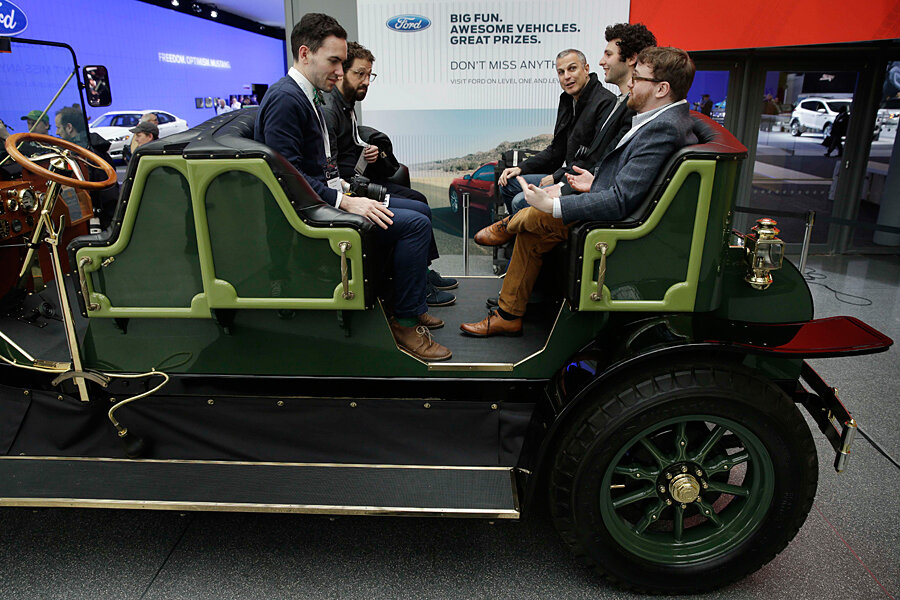Mayor's vision for horseless carriages in Central Park sputters
Loading...
| New York
Instead of the whinny and clip-clop of horse-drawn hansom cabs in Central Park, New York City Mayor Bill de Blasio prefers the ah-oo-gah ah-oo-gah of old-time cars.
The mayor was surprisingly insistent about the issue during the heady days of the fall campaign last year, when the candidate was a surprising mayoral upstart who catapulted into office and became the darling of America’s left. And even before his inauguration, Mr. de Blasio never wavered in his vow, putting it at the top of his early agenda.
“We are going to quickly and aggressively move to make horse carriages no longer a part of the landscape in New York City,” he said two days before his swearing-in.
Like his tax-the-rich plan to fund universal pre-K, however, his efforts to replace the city’s iconic horse-drawn carriages with electric vintage cars has lurched, sputtered, and backfired. Some 60 percent of both men and women registered to vote in the city have cried “Whoa!” to the mayor’s plans, according to a January Quinnipiac poll.
And for the past week, his proposed hansom cab ban has been one of the hottest political issues in town.
On Thursday, the proposed hansom cab alternative, the “Horseless eCarriage,” was unveiled at the New York International Auto Show to a general chorus of neighs.
The mayor hopes most of the 300 current carriage drivers will warm up to these brass-era replicas, commissioned by the group spearheading the horse carriage ban, New Yorkers for Clean, Livable and Safe Streets (known as NYClass). The organization was part of an animal rights coalition that gave $1.3 million to de Blasio and other carriage ban advocates on the city council.
But instead of galvanizing support for the ban, the unveiling of the Horseless eCarriage prompted the city’s newspapers to urge the mayor to drop his quest.
“While there is no lack of animal-welfare problems in the city – abused pets, feral cats, rats, Asian long-horned beetles, geese at the airports – New York’s well-treated, well-regulated carriage horses are not among them,” wrote The New York Times editorial board last week.
And the New York Daily News launched a full-throated “Save Our Horses” campaign, asking readers to sign a petition urging the mayor to abandon his plans.
On Saturday, however, 50 animal rights supporters who want the horses to be put out to pasture picketed in front of the Upper West Side apartment building of Liam Neeson, who has been outspoken in his support of the carriage industry. Protesters held signs saying, "Liam Neeson: Stop Supporting Cruelty."
In March, Neeson had taken reporters and a dozen City Council members on a tour of the stables housing the carriage horses, saying the animals are well-cared for.
“This is an industry that’s been here since before Abraham Lincoln’s first inauguration,” Neeson said inside the Clinton Park Stables. “A beautiful industry it is. It’s a connection with our past.”
Other New York celebs, however, including Alec Baldwin, Lea Michele, and Miley Cyrus have publicly supported the ban.
“Liam Neeson has abused his stature as a celebrity to promote lies among the general public,” Allie Feldman, head of NYCLASS, said to Newsday about Saturday’s protest. “Keep in mind, he is the only celebrity to ever support the abusive carriage-horse industry.”
But Neeson's advocacy helped to turn the political tide. At the start of the year, animal rights activists were giddy with anticipation. The expected ban, led by de Blasio and his liberal City Council in the media capital of New York, was considered one of the biggest potential victories in the movement’s history.
But so far, no bill has yet been introduced. The office of City Council Speaker Melissa Mark-Viverito, a previous supporter of the carriage ban, has declined to say when the issue would be put on the agenda.
Indeed, the heady days of the mayor’s landslide mandate seem further in the past each day, as another of his progressive changes for the city hits a snag.
“In a democracy, there's going to be differences," de Blasio said last week. "My bottom line is, it's just not humane, and we've got to do better."








